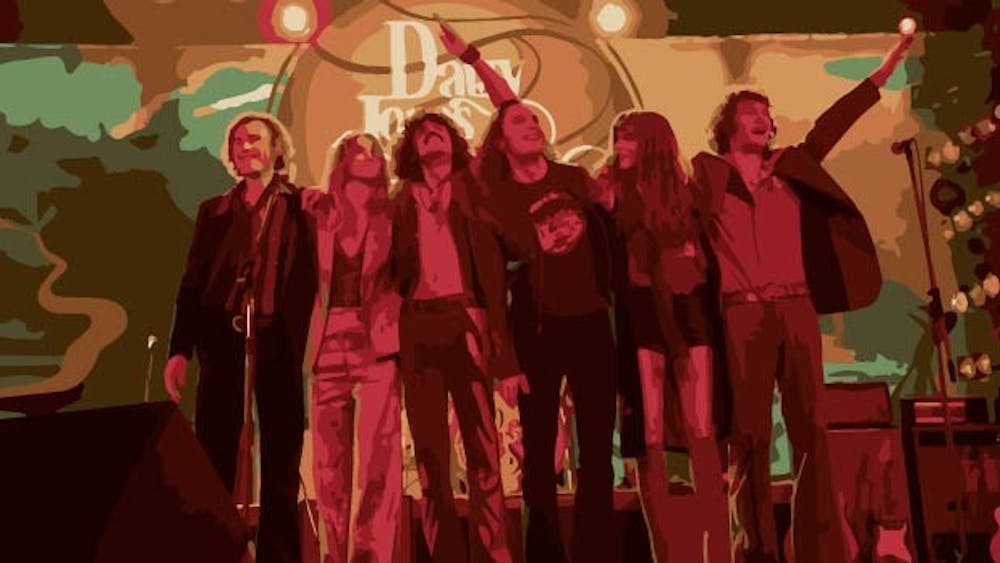The sights and sounds of the 1970s music scene transition from page to screen in the first three episodes of “Daisy Jones & The Six.” The highly anticipated series — based on the 2019 best selling novel of the same name by Taylor Jenkins Reid — depicts the fictionalized rise and fall of one of the world’s biggest rock bands.
The episodes premiered Friday on Prime Video, and the remaining seven are set to hit the platform in groups every Friday through March 24.
These opening episodes set the stage for the series, introducing the audience to who the characters are and how their story will be told. Remaining true to the oral history format used in the book, the show starts with the former rock stars — 20 years after their final performance and explosive break up — recounting their tumultuous personal and professional relationships and how Daisy Jones & the Six came to be in documentary style.
Accompanying these interviews are flashbacks of the moments they reference, which not only visualize the nostalgia-infused world Reid wrote about so vividly, but serve to confirm or contradict each character’s account of events with what actually happened.
While it’s the promise of sex, drugs and rock ‘n’ roll that draws in viewers unfamiliar with the source material, what makes this newest addition to the music drama genre so captivating is the show’s perfectly casted ensemble.
As the titular character of singer-songwriter Daisy Jones, Riley Keough gives a thrilling performance that expresses Daisy’s moxie and enchanting talent. The first three episodes show her transformation from a lost and lonely girl into a powerhouse who knows that she is more than just somebody’s muse — she is the somebody.
Sam Claflin’s portrayal of the Six’s frontman Billy Dunne is both charming and tragically compelling. Like Daisy, Billy is intense and stubborn to a fault. Claflin is able to make Billy sympathetic despite his misguided actions.
Heavily influenced by the style and sound of Fleetwood Mac — the British-American rock band — the relationship between Daisy and Billy emulates the complicated and rocky relationship between Fleetwood’s Stevie Nicks and Lindsey Buckingham. When Billy and Daisy finally meet in episode three, their chemistry is undeniable, and it establishes the creative and romantic tension that will build between them as the series progresses.
The rest of the Six flesh out the drama with their own storylines. Graham Dunne, played by Will Harrison, is the lead guitarist and Billy’s younger brother. His level-headedness foils Billy’s brashness, and his burgeoning feelings for British keyboardist Karen Sirko, played by Suki Waterhouse, add more romantic tension to the show.
Like Daisy, Karen is an intriguing character. These episodes highlight her determination to overcome the ideals of womanhood that the men project onto her.
Eddie Roundtree, played by Josh Whitehouse, is the bassist who harbors resentment for constantly being thrown in Billy’s shadow. His jealousy adds more intricacy to the group dynamic. Warren Rojas, played by Sebastian Chacon, is the drummer and comedic relief who’s been with the Six since their inception in Pittsburgh.
Camila Dunne, played by Camila Morrone, is Billy's wife and the unofficial sixth member of the Six. The band’s photographer and biggest supporter, Camila is another strong female character that acts with agency by refusing to be passive in her relationship with Billy.
The show also gives necessary screen time to characters who weren’t explored as much in the book. Simone Jackson, played by Nabiyah Be, is an aspiring disco singer who takes in a teenage Daisy Jones when she leaves home. Unlike in the novel, scenes are devoted to telling Simone’s story outside of her relationship with Daisy.
Along with the strong characterizations, the show’s music was a highlight. Accompanying the soundtrack of iconic 70s hits are original songs made by the band, where Fleetwood Mac’s influence can once again be found. From dimly lit and smokey bars on the Los Angeles strip to sepia-toned recording studios, these episodes are packed with impressive performances — performances in which the actors are actually playing their instruments and belting the lyrics.
With the folk, pop-rock sound that dominated the American west in this period, the music of “Daisy Jones & the Six” fuses heavy beats with catchy melodies. The entirety of “Aurora” — the band’s fictitious 1977 award-winning and multi-platinum selling album — was released in real life ahead of the show on Thursday.
Filled with music by Grammy-winning producer Blake Mills and collaborators, the album sounds authentic to the era. Songs like “Look At Us Now (Honeycomb)” — which samples “The Chain” by Fleetwood Mac — and “Let Me Down Easy” are reminiscent of classic tracks from that golden age of music.
These first installments of “Daisy Jones & The Six” sets the tone for the series and allow the audience to relish in the atmosphere of 1970s California. With a star-studded cast and a transportive look and sound, the next phases of episodes are sure to satisfy.







